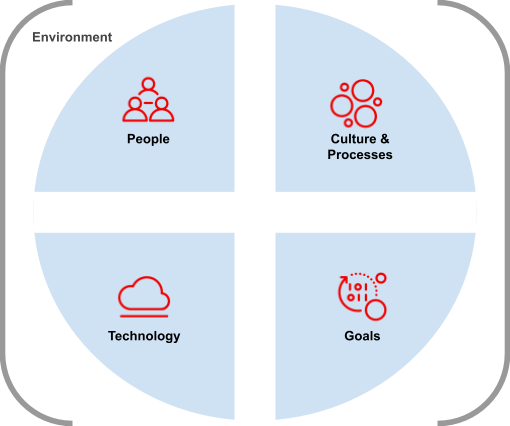Blog Red Hat
Building a technology adoption strategy is key to achieving business goals and maximizing value from technology. While building such a strategy, some barriers need to be addressed to drive more effective technology adoption. In this post, we discuss these barriers and how we might overcome them.
What do we mean by adoption?
When speaking about adoption, some might consider it more of a technology provider concern. Research has shown that actually, it is as much our customers' concern as Red Hat’s.
Indeed, when we look at customers who are using one or more of Red Hat’s products, we see elements that, together, define what success looks like for them independent of the segment and geographical location of their organization (Figure 1).
 Figure 1: Organizational elements that are regarded when planning the adoption of new technology
Figure 1: Organizational elements that are regarded when planning the adoption of new technology
-
People: the people the company relies on to drive business value
-
Technology: what the company uses to deliver business value for its customers
-
Culture and processes: the guiding principles and methods teams use to achieve the business goals
-
Goals: the outcomes that the company is seeking to achieve
-
Environment: the external variables that influence the adoption decision, such as geographical location, competition, business segment, etc.
These five key elements are all dependent on the fact that people are embracing and living the change induced by initiating a transformation journey where technology, processes, culture and goals shift according to a new strategy.
We consider an organization to be successful in adopting a new technology based on two factors:
-
A sufficient number of its workforce are using it as the technology of choice
-
Teams have adapted their ways of working according to the best practices to allow the business to be self-sustained
So the level of adoption is based on how many people are using it, and increasing that number should be a strategic goal.
Common customer attitudes towards technology
We identified three profiles for change acceptance within our customers’ teams when introducing a new Red Hat product (or a major product version in some cases):
-
Supporters: Those who are enthusiastic about the new technology and the benefits it will bring—these supporters are inclined to it as the technology of choice.
-
Neutrals: Those who are slow to adopt new technology as they see the potential risk and possible disruption of the status quo.
-
Detractors: Those who foresee significant risks, not only in adopting the technology itself but the disruption in the way they work.
What are some common barriers to success?
To understand these behaviors, we developed a model (Figure 2) to identify the barriers to successful adoption around four areas and make it easy for both Red Hat and our customers to build a remediation strategy.
 Figure 2: The four areas of adoption challenges
Figure 2: The four areas of adoption challenges
To go a step further, for each area, we identified a set of commonly faced barriers that impacted the adoption of the product or the change in the ways of working.
Technological challenges
Introducing a new technology or product nearly always comes with risks. The key to successful adoption is to show that the benefits outweigh those risks while also working to mitigate them.
Value
Product value awareness plays a crucial role in differentiating our offerings from other products on the market. For example: What does the OpenShift platform bring to developers and operations from a productivity and performance perspective, and what is its impact on achieving the business outcome?
Utilization
Here, we identified two major factors that are likely to impact the overall user experience:
-
Compatibility: What place does this technology hold in the current landscape? A common reason for customer resistance to a product or technology is that it may not be compatible with the existing technology landscape, workflows or practices.
-
Complexity: Usability is a driving factor for customers as they consider adopting new technologies. The steeper the learning curve, the less likely they will adopt it.
Risk
Two factors contribute to how the customer evaluates risk:
-
Functional: The risk of business disruption caused by environmental upgrades and uncertainty of how it will perform. Red Hat mitigates this kind of disruption by building a set of annex tools and best practices to our products.
-
Social: The risk of skills obsolescence for teams and the required time and effort for them to adopt new ways of working could lead to undesired consequences on how they are structured and how they communicate. Red Hat recommends planning on upskilling or reskilling teams and provides learning paths to help.
Financial challenges
These include investments and costs related to owning, operating and scaling the use of a new technology.
Total cost of ownership (TCO)
TCO is the sum of the direct and indirect costs across an organization over time. It includes the product subscription, the services necessary to accelerate the adoption, any upskilling, reskilling, training and communications and the future cost of downtime for migrations and upgrades and other productivity losses. TCO is carefully considered when deciding on the adoption of new technology and providing clarity helps customers evaluate the required investment to be successful.
Return on investment (ROI)
ROI is a primary consideration in deciding whether to invest in the new technology or product. This has a direct influence because customers often evaluate adoption based on these factors:
-
Expected overall value, impact on time to market and/or productivity
-
How long it will take to realize ROI
-
How much value is gained
IT chargeback
For many customers, the question of how to charge back the IT costs to other business units is part of the budgeting strategy. Not having a clear and established strategy can be a barrier to adopting the technology.
Organizational challenges
These included changes in organizational processes and culture and the impact on an organization's teams.
Leadership
Leadership-related barriers often come from two different factors:
-
Stakeholder misalignment: How each team is measured—such as management by objectives (MBOs) and key performance indicators (KPIs)—can impact how teams react towards a new technology.
-
Risk assessment: When the perceived value and usefulness of the technology is outweighed by the required investment (time and resources) to allocate to use it, leaders might resist adopting the technology.
Culture and processes
Adopting new technology often requires changing how things are done, which might require a change in the organization's culture to get full value from that technology.
Since culture is the system of values and beliefs that governs the overall strategy, culture change requires adherence to be effective. In order to achieve that level of commitment, processes need to reflect that change when they are designed and implemented.
Teams
Teams face different barriers in the effort to adopt new technology:
-
Structure: How teams communicate and collaborate to deliver value is a widespread problem. There are a number of variables that, if not taken into consideration, will lead to reduced proficiency and performance. It's important to look at different facets such as skillset, processes, tools etc. to avoid silos and ensure effective communication and collaboration.
-
Enablement: Onboarding and enablement make up the foundation for high performing teams. Having strategies for transforming and upskilling teams is essential to ensure proficiency with the new technology.
Psychological challenges
These include beliefs and habits that can impact the adoption of new technology.
Habits
A major source of psychological resistance in adopting a new technology is the disruption of the system of habits or accepted norms of behavior. For instance, adoption of a new technology requires deviation from established traditional ways of working and, in some cases, redefine roles and responsibilities within teams. This can be psychologically threatening as it does not support traditional patterns and may lead to impulsive resistance.
Adopting an incremental approach can help mitigate the disruption and, by extension, the resistance to change.
Perception
Perception is often the first barrier when initiating change, whether that change includes a new technology, product version, ways of working or, as often happens, a mixture of these elements.
Understanding users' cognitive processes and having some idea how they will respond to adopting new technology or a product is essential.
Three elements influence a team’s perceptions about technology:
-
Image and branding: Attitudes and feelings about a technology provider or product.
-
Usefulness: How useful a product will be to the organization and the perceived impact they want to achieve.
-
Experience: Expectations about the level of complexity and compatibility with the current technology landscape and how work is done.
Conclusion
In this post, we focused on analyzing what obstacles can prevent organizations from adopting a technology based on our experience and customer feedback. A proper understanding and assessment of these barriers will help you build an effective adoption strategy. In a future post, we will share some proven adoption strategies that you can try.
If you would like to learn more, we employ open source tools and practices like the Open Practice Library to help visualize and uncover hidden elements as well as strategize based on the information at hand.
À propos de l'auteur
As a global Adoption Practice Lead, Riadh is working with customers, partners and Red Hatters to identify barriers and build strategies for achieving business outcomes using open source technologies and practices.

